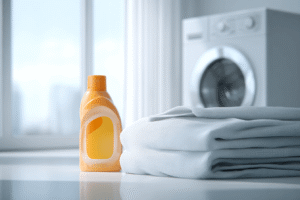Summarise this article with:
Getting your bed sheets properly clean in the washing machine doesn’t have to be complicated. We’ve put together this comprehensive guide to help you master the right settings, avoid common pitfalls, and keep your bedding fresh and long-lasting. Whether you’re dealing with cotton, silk, or polyester blends, the right approach makes all the difference.

How Often Should You Wash Your Bed Sheets?
Most people should wash their sheets once a week to maintain proper hygiene and sleep quality. However, your personal circumstances might require adjustments to this schedule.
Here’s when you should wash more frequently:
- Every 3-4 days: If you have pets sleeping in your bed
- Twice weekly: During hot summer months when you sweat more
- After illness: Always wash immediately to prevent reinfection
Every two weeks works if you:
- Shower before bed regularly
- Don’t have allergies or sensitive skin
- Use a mattress protector
Remember, fresh sheets aren’t just about comfort – they help eliminate dust mites, dead skin cells, and body oils that accumulate naturally. We spend roughly 56 hours per week in bed, so keeping your bedding clean directly impacts your health and sleep quality.
Preparing Your Bedding for the Washing Machine
Check Care Labels and Fabric Types
Before you toss your sheets in the washing machine, take a moment to check those little labels – they’re your best friend for avoiding laundry disasters.
Different fabrics need different care:
| Fabric Type | Water Temperature | Special Notes |
|---|---|---|
| Cotton Sheets | Warm to hot (40-60°C) | Durable, can handle higher temperatures |
| Linen Sheets | Cold to warm (30-40°C) | Air dry preferred, wrinkles naturally |
| Silk Sheets | Cold water only (30°C) | Gentlest cycle, hand wash recommended |
| Polyester Blends | Warm water (40°C) | Quick-drying, avoid fabric softener |
Key care label symbols to watch for:
- Dots inside washing symbols indicate temperature (more dots = hotter)
- Hand symbol means gentle cycle or hand wash only
- Crossed-out triangle means no bleach
When in doubt, follow the most delicate material’s instructions if you’re washing mixed fabric types together.
Pre-treat Stains Before Washing
Spot any marks on your sheets? Don’t panic – most stains come out beautifully with the right pre-treatment approach.
Quick action makes all the difference. Fresh stains respond much better than set-in ones, so tackle them as soon as you notice them.
Here’s your stain-busting toolkit:
- For sweat and body oils: Apply washing up liquid directly to the stain and gently work it in with your fingers
- For blood stains: Rinse immediately with cold water, then dab with hydrogen peroxide
- For food and drink spills: Blot (don’t rub!) with a clean cloth, then treat with pre-wash stain remover
- For makeup and fake tan: Mix dish soap with a splash of micellar water and let it sit for 30 minutes
Let your treatment work for 5-10 minutes before popping the sheets into the washing machine. This gives the products time to break down the stain properly, making your wash cycle much more effective.
Separate Light and Dark Bedding
Colour separation isn’t just old-school thinking – it genuinely protects your favourite sheets from unwanted dye transfer and keeps whites looking crisp.
| Light Bedding | Dark Bedding |
|---|---|
| White, cream, pale pastels | Navy, black, deep colours |
| Wash with warm water | Cold water prevents fading |
| Can handle brighter wash cycles | Gentle cycle preserves colour |
Sort your sheets before loading:
- New dark sheets need their first few washes alone – they’re the biggest culprits for colour bleeding
- White and light coloured sheets should never share a load with darks
- Mixed-colour patterns go with whichever shade dominates
Good news: light grey and beige sheets can usually join your white wash without drama. The key is washing similar tones together so nobody gets an unwanted makeover in the machine.
What Setting Should You Use to Wash Bed Sheets?
Cotton and Linen Sheet Settings
Cotton sheets are wonderfully forgiving – they can handle most washing machine settings without drama. Set your machine to a normal or cotton cycle with warm to hot water (40-60°C). The robust fibres thrive with regular cycles and higher temperatures.
Linen requires gentler handling despite being a natural fibre like cotton. Use a gentle cycle with cold to lukewarm water (30-40°C maximum) to prevent shrinkage and maintain that lovely relaxed texture.
Top tips from cleaning experts:
- Cotton: Medium to high spin speed works perfectly
- Linen: Low spin speed prevents excessive creasing
- Both fabrics: Avoid much detergent – natural fibres need less than synthetic materials
- Tumble dryer settings: Low heat setting for linen, medium heat for cotton
Weather permitting, air-drying gives both fabrics the best finish and extends their lifespan significantly.
Delicate Fabrics: Silk and Satin Settings
Turn your silk and satin sheets inside out before washing to protect their lustrous finish from friction damage during the cycle.
Machine settings for delicate success:
| Silk Sheets | Satin Sheets |
|---|---|
| Cold water only (30°C max) | Cold to lukewarm (30°C) |
| Delicate/gentle cycle | Gentle cycle with slow spin |
| Mild detergent for silk | pH-balanced gentle detergent |
Place sheets in mesh laundry bags for extra protection against snags and stretching. Never use fabric softener or bleach – these products damage the fibres and dull the natural sheen.
Hand washing remains the gentlest option if you’re concerned about your machine’s delicate cycle. Use cool water and avoid wringing or twisting the wet fabric.
Air-dry flat or hang away from direct sunlight to prevent colour fading and maintain the fabric’s smooth texture.
Polyester Blend Washing Requirements
Polyester blends offer the perfect balance between durability and easy care, making them a popular choice for busy households.
Set your machine to warm water (30-40°C) for optimal cleaning without damaging the synthetic fibres. A normal or regular cycle works brilliantly for most polyester-cotton blends.
| Water Temperature | Cycle Type | Spin Speed |
|---|---|---|
| Warm (30-40°C) | Normal/Regular | Medium |
Key care points:
- Avoid fabric softener – it reduces breathability
- Don’t overload your machine for thorough cleaning
- Skip the hottest water settings to prevent pilling
The beauty of polyester blends? They’re naturally wrinkle-resistant and dry quickly, making them a brilliant choice when you need fresh bedding in a hurry.
Temperature Guide: Should You Wash Bed Sheets at 40 or 60 Degrees?
Wondering which temperature does the job best? The choice between 40°C and 60°C depends on your specific needs and circumstances.
| 40°C Wash | 60°C Wash |
|---|---|
| Energy-efficient and gentle on fabrics | Superior bacteria and dust mite elimination |
| Perfect for regular weekly washing | Essential during illness or allergies |
| Suitable for most cotton bedding | Ideal for heavily soiled sheets |
Choose 40°C when:
- Your sheets aren’t heavily soiled
- You wash weekly and want to save energy
- Following care label recommendations
Go for 60°C if:
- Someone’s been unwell recently
- You suffer from dust mite allergies
- It’s been longer than two weeks since washing
Remember: Modern detergents work effectively at both temperatures, so your washing frequency matters more than the heat setting for most households.
Loading Your Washing Machine Properly
Can a 7kg Washing Machine Wash Bed Sheets?
A 7kg washing machine handles bed sheets brilliantly – you’ve got plenty of space for most household bedding needs without cramming everything in.
Here’s what fits comfortably in your 7kg drum:
- Double bed sheets: 1-2 complete sets (fitted sheet, flat sheet, pillowcases)
- Single bed sheets: 2-3 complete sets easily
- King size sheets: 1 set maximum to avoid overloading
Weight guide for planning your loads: A typical double bed sheet weighs around 0.5kg, so you’re well within capacity limits. Leave space for water and detergent to circulate properly – your sheets need room to move for effective cleaning.
Good idea: Mix one set of sheets with a few towels to maximise your wash efficiency without stuffing the drum.
How Many Bed Sheets Can You Wash Together?
The magic number depends on your machine’s capacity and sheet size – but don’t worry, we’ve got the perfect guide to help you get it spot on.
| Machine Capacity | Sheet Sets You Can Wash | Best Practice |
|---|---|---|
| 6-7kg | 1 queen set + pillowcases | Leave room for movement |
| 8-9kg | 1 king set OR 2 single sets | Don’t cram everything in |
| 10kg+ | 2 double sets maximum | Check fabric weight too |
Key guidelines for washing multiple sheets:
- One complete set per standard load works brilliantly for most households
- Two single bed sets fit comfortably in most 7kg+ machines
- Never exceed 70% drum capacity – your sheets need space to circulate properly
Fabric matters too: Heavyweight cotton takes more room than lightweight microfibre, so adjust accordingly. Overloading means poor cleaning and potential damage to both your machine and bedding.
Brand-Specific Washing Machine Settings
Samsung and LG Bedding Programmes
Both Samsung and LG offer dedicated bedding cycles that take the guesswork out of washing your sheets and duvet covers properly.
| Samsung Bedding Cycle | LG Bedding Programme |
|---|---|
| Gentle drum rotation with increased water levels | Specialised wash motions for bulky items |
| Controlled spin speeds (800 rpm maximum) | Extra rinses to remove detergent residue |
| 40°C temperature limit for fabric protection | Steam options available on select models |
Samsung’s approach focuses on fabric care through slower agitation and extended wash times, perfect when you’re concerned about bed bugs or allergens. Their cycle prevents tangling while ensuring thorough cleaning.
LG takes a different route with powerful wash motions designed specifically for items that struggle to absorb water. Their programme includes additional rinses, making it excellent for thick bedding that needs extra detergent removal.
Quick tip: Both brands recommend washing bedding separately from other items. This prevents your sheets from wrapping around smaller garments and ensures optimal water circulation for effective cleaning.
Bosch and Candy Machine Recommendations
Bosch machines excel with their Cotton programme for bed sheets, while Candy offers specialised cycles that handle bedding with care.
| Bosch Settings | Candy Settings |
|---|---|
| Cotton cycle at 60°C for thorough sanitising | Bedding programme with gentle agitation |
| Speed Perfect option for quicker washes | Low spin setting to prevent sheet damage |
| Extra rinse function for sensitive skin | Cold wash option for delicate fabrics |
Bosch recommendations:
- Use 60°C Cotton setting for weekly sheet washing
- Select extra rinse if anyone has allergies
- Avoid Speed Perfect for heavily soiled bedding
Candy recommendations:
- Choose the dedicated bedding programme for thick sheets
- Set spin to low speed to minimise wrinkles
- Consider their sanitising products for enhanced cleanliness
Both brands handle standard double bed sheets comfortably, though ironing may be needed if you prefer crisp finishes.
Step-by-Step Washing Process
Detergent Selection and Measurement
Choosing the right detergent makes all the difference between fresh, clean sheets and a disappointing wash that leaves you wondering what went wrong.
Liquid vs powder detergents each have their strengths:
| Liquid Detergent | Powder Detergent |
|---|---|
| Dissolves easily in cold water | More effective for general cleaning |
| Perfect for pre-treating stains | Better value for money |
| Gentler on delicate fabrics | Works brilliantly in hot water cycles |
Measurement guidelines for standard loads:
- Quarter cup of liquid works perfectly for regular-sized bedding loads
- Half cup for heavily soiled sheets or larger king-size sets
- Follow the cap measurements – most bottles include handy measuring guides
Consider hypoallergenic options if anyone in your household has sensitive skin, and remember that using too much detergent can actually make your sheets feel stiff and reduce their lifespan.
Cycle Selection and Spin Speed
Your washing machine’s cycle and spin settings work together to give your sheets the care they deserve without causing unnecessary wear.
Most cotton sheets thrive on a normal cycle with medium spin speed (around 1000-1200 rpm), while delicate fabrics like silk need gentler treatment with low spin speeds under 800 rpm.
| Fabric Type | Recommended Cycle | Spin Speed |
|---|---|---|
| Cotton sheets | Normal/Cotton | 1000-1200 rpm |
| Linen bedding | Normal cycle | 800-1000 rpm |
| Silk/Satin | Delicate/Gentle | 600-800 rpm |
| Polyester blends | Easy Care | 1000 rpm |
Higher spin speeds extract more water, reducing drying time but potentially causing more creasing. Lower speeds are kinder to fabrics but leave sheets damper, requiring longer drying periods.
Fabric Softener: When to Use It
Feeling confused about fabric softener for your bedding? You’re not alone – this little addition can make your sheets feel lovely, but timing matters.
| Use Fabric Softener When | Skip Fabric Softener When |
|---|---|
| Cotton sheets feel stiff after washing | Washing microfibre or moisture-wicking fabrics |
| You want extra softness and fragrance | Dealing with very sensitive skin |
| Sheets will be stored for long periods | Washing towels (reduces absorbency) |
Add fabric softener to your machine’s designated compartment before starting the wash cycle – never pour it directly onto dry sheets. For a standard load, 35ml does the trick beautifully.
Quick alternatives: White vinegar works as a natural softener if you prefer chemical-free options, or try wool dryer balls for a gentle, eco-friendly approach.
Common Mistakes When Washing Bed Sheets
Overloading Your Machine
Cramming too many sheets into one wash might seem efficient, but this shortcut creates more problems than it solves.
When your machine is packed tight, water and detergent struggle to circulate properly. The result? Sheets that emerge still grubby and potentially damaged from excessive friction against each other.
Overloading risks include:
- Poor cleaning performance due to restricted water flow
- Increased wear on both your sheets and machine components
- Unbalanced loads causing excessive vibration and noise
- Potential motor strain leading to costly repairs
How much is too much? If you can’t fit your hand comfortably into the drum after loading, you’ve gone overboard. One complete sheet set per wash works best – your machine will thank you, and your bedding will emerge properly cleaned and cared for.
Using Wrong Temperature Settings
Getting the temperature wrong can wreak havoc on your favourite sheets – and we see this mistake more often than you’d think.
Too hot and you risk:
- Shrinkage that turns your double sheets into single-size disasters
- Colour fading that leaves vibrant bedding looking washed out
- Fabric damage to delicate fibres like silk or bamboo
Too cold creates different problems:
- Bacteria and dust mites survive the wash cycle
- Body oils and sweat stains refuse to budge properly
- Unpleasant odours linger despite using quality detergent
| Fabric Type | Safe Temperature | Avoid |
|---|---|---|
| Cotton (white) | Up to 60°C | Boiling water |
| Cotton (coloured) | 40°C maximum | Hot cycles |
| Silk/Satin | 30°C only | Anything above warm |
The sweet spot? Check those care labels religiously – they’re there for good reason and save you from expensive replacement shopping.
Mixing Bedding with Other Clothes
Tempted to throw everything into one big wash? We get it – laundry day can feel overwhelming, but mixing your sheets with clothes creates more hassle than help.
Here’s what happens when you combine them:
- Clothes get tangled inside duvet covers and fitted sheets
- Zips and buttons can snag delicate bedding fabrics
- Different fabric weights prevent proper water circulation
- Your sheets won’t get the thorough clean they deserve
The golden rule? Wash your bedding separately from clothing items. Pillowcases are the exception – these smaller pieces can join your regular clothes wash without causing drama.
If you absolutely must combine loads, stick to similar fabric weights and colours only. Your sheets will stay in better condition, and you’ll avoid the frustration of untangling everything from the drum.
Drying and Caring for Clean Bedding
Once your sheets emerge from their wash cycle, proper drying makes all the difference between bedding that lasts years and fabric that deteriorates quickly.
Air-drying remains the gentlest option for extending your sheets’ lifespan. Hang them outside when possible – natural sunlight acts as a brilliant disinfectant and leaves cotton feeling wonderfully soft.
For tumble drying, stick to low or medium heat settings to prevent shrinkage and fabric damage. Remove sheets while slightly damp to minimise wrinkles, then give them a quick shake before folding.
| Drying Method | Best For | Time Required |
|---|---|---|
| Air-dry outdoors | All fabrics | 2-4 hours |
| Tumble dry low | Cotton, polyester | 45-60 minutes |
| Flat dry | Silk, delicate fabrics | 4-6 hours |
Storage matters too – fold sheets neatly and store in a cool, dry place. Avoid plastic bags which trap moisture and can cause mildew problems down the line.
Special Considerations for King Size and Kids’ Bedding
King size bedding demands serious washing machine muscle – you’ll need at least a 9kg capacity to handle a complete set without cramming.
Children’s bedding requires different thinking entirely. Frequent accidents and sensitive skin mean you’ll want hypoallergenic detergent and higher wash temperatures to eliminate bacteria and allergens effectively.
| Bedding Type | Machine Capacity | Special Requirements |
|---|---|---|
| King size complete set | 9-10kg minimum | Wash alone, extra rinse cycle |
| Kids’ single set | 6-7kg sufficient | Hot wash (60°C), hypoallergenic products |
Pro tip for parents: Pre-treat stains immediately and consider waterproof mattress protectors to reduce washing frequency. King size users should invest in two sets to rotate while one’s in the wash – nobody wants to sleep on damp sheets after a late-night laundry session.









